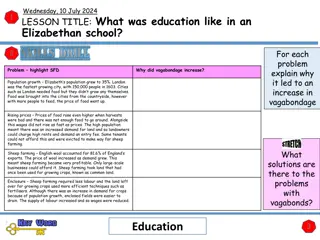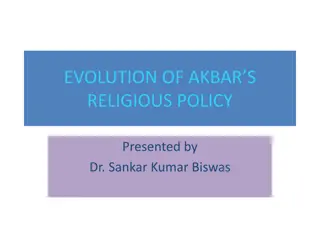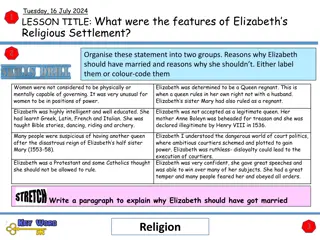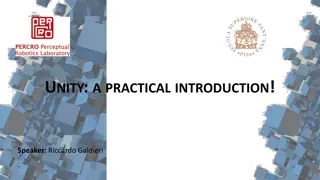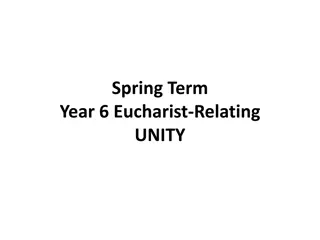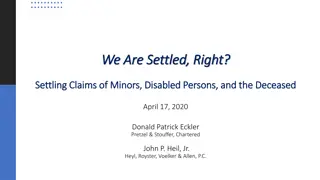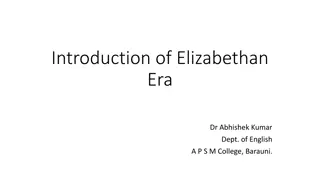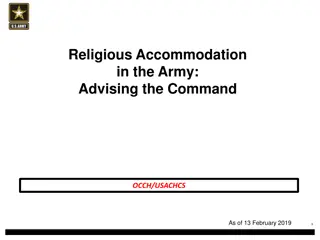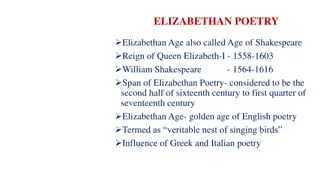Elizabethan Religious Settlement: Unity Amidst Division
Amid religious division in England, Queen Elizabeth I implemented a Religious Settlement in 1559 to unify the country. The settlement, a blend of Protestant and Catholic elements, aimed to maintain peace and prevent rebellions. Elizabeth's strategic compromise pleased most people, though lingering threats from the Catholic faith persisted. The Acts of Supremacy and Uniformity, along with Royal Injunctions, played key roles in defining religious practices as prescribed by the state. Explore the complexities of Elizabethan England's religious landscape and the diplomatic efforts of its ruler.
Download Presentation

Please find below an Image/Link to download the presentation.
The content on the website is provided AS IS for your information and personal use only. It may not be sold, licensed, or shared on other websites without obtaining consent from the author. Download presentation by click this link. If you encounter any issues during the download, it is possible that the publisher has removed the file from their server.
E N D
Presentation Transcript
Thursday, 18 July 2024 LESSON TITLE: Religious Settlement PARC Feedback
Thursday, 18 July 2024 LESSON TITLE: Religious Settlement Where did most protestants live? What did Protestants believe should happen to the bible? How many protestants did Queen Mary burn? What is an antiseptic? What celebrity made chloroform popular? Which doctor had a 300% death rate in one surgery?
How did Elizabeth I try to solve the religious divisions of England in 1559? To assess why Elizabeth would introduce the religious settlement in 1559. Mastering To explain why England was so religiously divided in the 16th Century. Securing Developing To describe how England was religiously divided.
I have a problem with religion in my country. It means England is significantly divided. What should I do? Answer in a full sentence what you would do if your were Elizabeth I.
What were the features of Elizabeths Religious Settlement? Elizabeth and the Privy Council spent the autumn of 1558 drawing up plans for a new Church: then Elizabeth called a meeting of Parliament in 1559. Elizabeth hope that her plans would be approved quickly, but there was some opposition from the Catholic Lords and Bishops. Elizabeth responded by arresting two Catholic Bishops who did not like her new Church. Elizabeth changed her title from Supreme Head of the Church to Supreme Governor (to make Catholics happy as they saw the Pope as the Head of the Church). Parliament passed the Acts of Supremacy and Uniformity which made the changes legal. England became a Protestant country again, but the Church kept some Catholic traditions. This meant that the Religious Settlement of 1559 was a compromise so that all faiths should be happy. Elizabeth did not want religious divisions to lead to rebellions, nor did she want to punish people for their religious beliefs (this had made Mary Tudor very unpopular before). The result was that most people accepted the Church. There were no immediate rebellions or threats to her power. However, in the long-term the threat of the Catholic faith did not completely disappear.
TASK Using page 21 (or slide 7) write down a definition of the following The Act of Supremacy The Act of Uniformity Royal Injunctions What did the Act of Uniformity say about how religion should be practised? Bible and church services When they should attend church What happens if they did not attend What were the rules under the Royal Injunctions? What should each parish have? What were banned? What should the clergy wear? Why was it important to Elizabeth to introduce this settlement?
1. Why might Elizabeths Religious Settlement keep Catholics happy? 2.Why might Elizabeth s Religious Settlement keep Puritans happy? 3.Which different aspects of the religious Settlement would Catholics and Puritans dislike?
Why might Elizabeths Religious Settlement keep Catholics contented? - Decoration of churches still allowed. - Could still believe what they liked about Holy Communion. - Catholics would not be arrested or burned. Why might Elizabeth s Religious Settlement keep Puritans contented? - - England was to be a Protestant country. - Puritans could return to England and would not be persecuted. Which different aspects of the religious Settlement would Catholics and Puritans dislike? Puritans would dislike: Ornamentation in the churches That there was tolerance of some Catholic ideas Catholics would dislike: The new prayer book. That priests were now allowed to marry. Why was it so important to Elizabeth to introduce this settlement? - - - An early signal of her desire to control the kingdom. To avoid unrest over religion. To allow her more security on the throne.
How successful was Elizabeths Religious Settlement? Elizabeth wanted a Protestant Church that Catholics could accept. She did not want them to feel forced to choose between loyalty to their religion and their queen, so she wanted to keep a Catholic feel to churches. As long as people conformed outwardly, Elizabeth did not want persecution. She hoped that the Catholic faith would simply fade away in England as the old clergy died out. TASK Read the statements and identify whether the Religious Settlement was a success or a failure. Explain why. Was Elizabeth s religious settlement an overall success or failure? Explain your reasoning.
Was the Religious Settlement a success or a failure?Explain why Statement 1. All members of the Church had to take the oath of supremacy under the Act of Supremacy. 8,000 priests and less important clergy did so. However only one Bishop agreed to take the oath. Elizabeth then appointed 27 new (Protestant) bishops. 2. The majority of ordinary people accepted Elizabeth s Religious Settlement and attended the Church of England services. The wording of the new Prayer Book helped this because it could be understood to mean different things by Catholics and Protestants according to their beliefs. 3. There were ways around the Elizabethan Religious Settlement for committed Catholics. For example, many attended church but then had private Catholic services in their homes. 4. Although Church courts mainly focused on Church matters, they did act in a range of minor disputes on moral issues. Examples of moral issues dealt with by the Church included marriage, sexual offences and slander (false insults). Church courts also dealt with wills and inheritance. Some lawyers didn t like that the Church began dealing with legal matters. 5. Visitations were inspections of churches and clergy by bishops to ensure that everyone took the oath of supremacy and were following the terms of the religious settlement. In this way, the Church was able to monitor other professions for the government.
A Describe two features .. A01 4 marks N WF Name + Explain X2 One feature of is . This is/was A second feature is This is/was...
4 marks A01 Describe two features of Elizabeth s religious settlement Sentence starters: Point One feature of the Elizabeth s religious settlement was SFD This was Point Another feature of the Elizabethan religious settlement was SFD This was KEY Point Annotate your work to show where you have given a new point and where you have used specific factual detail. SFD
Did Elizabeth deal with the issue of religion successfully? Not successful Very successful In one sentence, explain how successful you think Elizabeth was with dealing with the issues of religion using the word because .








